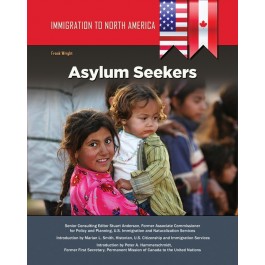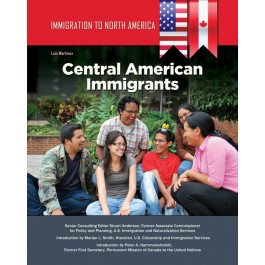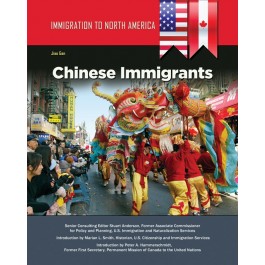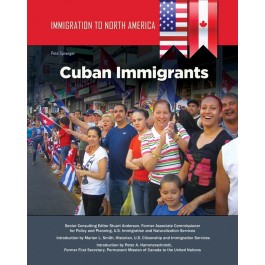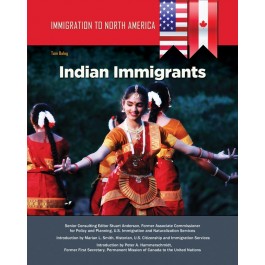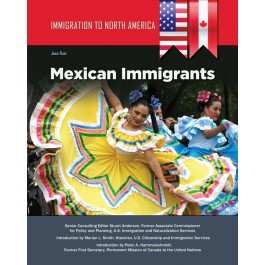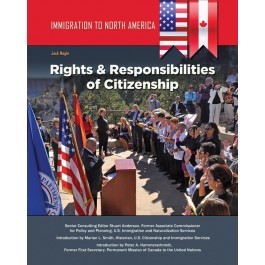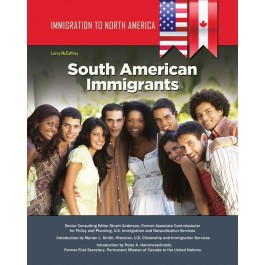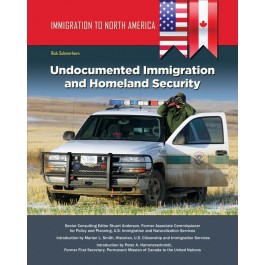IMMIGRATION TO NORTH AMERICA

8
2017
12+
7th - 12th
7.5 x 9.5
SLJ Review
Most of these titles were published in Mason Crest’s “The Changing Face of North America” set from 2004 and retain much of their original format and most of their chapter topics. The amount of revision varies. Refugees, Cuban Immigrants, and Middle Eastern Immigrants each have had substantial changes made to their historical and current information. Others, such as South American, have fewer tweaks, mostly new statistics and updates based on recent events. Coverage is objective, and the books are well written and describe the “push” and “pull” factors that draw immigrants to North America and how the Canadian and U.S. governments and their respective citizens have responded to different groups and circumstances. There is more material on the United States than on Canada. This set’s current data is good, but revisions aren’t total, and some popular culture references are dated—a significant weakness. VERDICT Updated enough to be an adequate supplemental purchase where needed.by Frank Wright
| eBook | ISBN 978-1-4222-8097-3 | $32.95 | Add To Cart |
Asylees are people who cannot return to their homeland because of a fear of persecution. Unlike other refugees, asylees are processed within the country where they find refuge. They are permitted to stay when that country determines that they have a legitimate and compelling reason for leaving their homeland. People seeking asylum in the United States or Canada comprise a diverse group. Some have escaped persecution in their homeland and have migrated illegally to North America via boat, plane, or on foot. Others have arrived legally on temporary visas and request asylum only after learning that their home country has become too dangerous for them to return. This book covers the history of the asylum process in North America, as well as the step-by-step process by which a person receives asylum. It also provides examples of cases in which people have found safe haven in the United States and
Canada.
by Luis Martinez
| Hardcover | ISBN 978-1-4222-3686-4 | $25.95 | Add To Cart |
| eBook | ISBN 978-1-4222-8103-1 | $32.95 | Add To Cart |
Poverty and political violence have driven many people from Central American countries to immigrate to the United States or Canada. Beginning in the 1980s, wars and repression drove large numbers of immigrants north. By 2014, according to data from the US Census Bureau, immigrants from Central America made up about 7 percent of the country’s total immigrant population. This book briefly chronicles the often-troubled history of the region’s seven countries—Belize, Costa Rica, El Salvador, Guatemala, Honduras, Nicaragua, and Panama—and examines the experiences of those who have left to find a new life in North America. Despite many hardships, Central Americans have established vibrant communities throughout the United States and
Canada.
by Jiao Gan
| Hardcover | ISBN 978-1-4222-3684-0 | $25.95 | Add To Cart |
| eBook | ISBN 978-1-4222-8101-7 | $32.95 | Add To Cart |
With about 1.4 billion people, China is the most populated nation in the world. However, overpopulation is only one of the country’s many pressing issues. China’s communist government has initiated economic reforms in recent decades, yet it still enforces oppressive measures on its people. Many Chinese seek to resettle in North America, where they may find better economic opportunities and are assured basic rights like freedom of expression and religion. Today, Chinese immigrants make up the third-largest foreign-born group in the United States, numbering over 2 million people. Chinese immigrants are the second-largest foreign-born group in Canada, at over 600,000. Although at one time Chinese immigrants were met with discrimination and prejudice, changing attitudes in North America have led to greater recognition and acceptance of this immigrant group’s contributions to American and Canadian
societies.
by Pete Spranger
| Hardcover | ISBN 978-1-4222-3685-7 | $25.95 | Add To Cart |
| eBook | ISBN 978-1-4222-8102-4 | $32.95 | Add To Cart |
Cuban immigrants have been coming to the United States and Canada for years. Many have fled the repressive communist system, seeking freedom in the north. The Cuban exiles of recent decades have united to become an influential economic and political force, particularly in the United States. Since 1959, the United States has welcomed hundreds of thousands of Cuban immigrants. Some exiles have traveled comfortably in airplanes; others have braved the dangerous Straits of Florida in shoddy rafts. US leaders have sometimes modified immigration policy, often in response to the massive waves of Cuban migrants, like those arriving in the boatlifts of 1980 and 1994. Leaders of the Cuban American community have encouraged the US government to continue offering refuge to the migrants who need it. The restoration of diplomatic relations between the United States and Cuba in 2015 has led to another surge in immigrants in the past few
years.
by Tom Balog
| Hardcover | ISBN 978-1-4222-3687-1 | $25.95 | Add To Cart |
| eBook | ISBN 978-1-4222-8104-8 | $32.95 | Add To Cart |
The people of the Republic of India make up the world’s second-largest population, numbering over 1.2 billion, yet they live in a country with an area that is only about one-third the size of the United States. India faces many problems, including overcrowding, extensive poverty, and wide-scale pollution. These conditions, along with the attractive opportunities available in other countries, have compelled many Indians to emigrate. Indian immigrants have made diverse contributions to the national fabrics of Canada and the United States in the areas of religion, philosophy, commerce, fashion, and cuisine. Indian Americans have also made inroads into high-tech fields and other industries. However, many immigrants, particularly those arriving with minimal experience and education, still face the threat of being exploited in the North American workplace. Despite this, immigrants from India are likely to continue resettling in the United States and Canada in large
numbers.
by Jose Ruiz
| Hardcover | ISBN 978-1-4222-3688-8 | $25.95 | Add To Cart |
| eBook | ISBN 978-1-4222-8105-5 | $32.95 | Add To Cart |
Mexicans are the largest immigrant group in the United States. In 2014, the most recent year for which data is available, they accounted for over 28 percent of the total US foreign-born population. The number of Mexican immigrants to Canada has also been rising steadily since the 1960s. Mexicans are attracted by the greater job opportunities available in the United States and Canada, as well as the opportunity to escape the violence involving drug cartels and the Mexican government. Most Mexican immigrants arrive in the country legally, although illegal immigration has been a problem for many years. In both the United States and Canada, government organizations have worked to prevent illegal migration, while political groups have been formed to advocate for the rights of both legal and undocumented immigrants from
Mexico.
by Ed Warms
| eBook | ISBN 978-1-4222-8106-2 | $32.95 | Add To Cart |
The Middle East, which nurtured some of the world’s earliest civilizations, is today a region of diverse peoples and cultures. It is also a region beset by political, social, and religious conflicts—including devastating civil wars in Syria, Iraq, Libya, and Afghanistan. Thus many people have left their homelands in hopes of finding a safer life elsewhere. Middle Eastern immigrants have been arriving on North American shores since the late 1800s, but in recent decades their numbers have risen dramatically. A wave of refugees fleeing from Syria and Afghanistan in 2015 and 2016 has caused political turmoil, as American and Canadian leaders debate whether to permit them into their societies. Though the contributions of Middle Easterners have long enriched North American society, the future of Middle Eastern immigration appears
uncertain.
by Jack Nagle
| Hardcover | ISBN 978-1-4222-3682-6 | $25.95 | Add To Cart |
| eBook | ISBN 978-1-4222-8099-7 | $32.95 | Add To Cart |
Citizenship is the common thread that connects all Americans. The United States is a nation that is bound not by race or religion, but by shared values such as freedom, liberty, and equality. Throughout its history, the US has taken in immigrants from all over the world. Their contributions have helped to shape and define the United States today. This book provides an easy-to-read overview of the rights and responsibilities that all US citizens should exercise and respect. It provides information on the citizenship test that immigrants must pass, as well as on the US government and how it works. The book provides an introduction for anyone wanting to learn more about what it means to be a citizen of the United States of
America.
by Larry McCaffrey
| Hardcover | ISBN 978-1-4222-3690-1 | $25.95 | Add To Cart |
| eBook | ISBN 978-1-4222-8107-9 | $32.95 | Add To Cart |
Over the past seven decades, immigration to the United States from the countries of South America has increased dramatically. In 1960 South American immigrants made up about 1 percent of the total foreign-born population in the United States. By 2014 that share had increased to 7 percent of the nation’s 42.4 million immigrants. Immigrants from South America are typically driven north by economic crises and political unrest in their own countries. South American Immigration surveys the recent history of the twelve nations that make up the world’s fourth-largest continent, focusing particularly on the countries that have sent the largest number of immigrants to North America. It examines why these people have left their homelands, how they have adapted to and changed North American culture, and what the future might hold for them in the United States and
Canada.
by Rick Schmerhorn
| Hardcover | ISBN 978-1-4222-3683-3 | $25.95 | Add To Cart |
| eBook | ISBN 978-1-4222-8100-0 | $32.95 | Add To Cart |
With the borders and coastlines of the United States stretching over 16,000 miles, enforcing immigration laws is no easy task. Every year thousands of immigrants illegally cross the country’s borders, reach its shores, and pass through its airports. A primary task of the US immigration system, which is part of the Department of Homeland Security, is tracking down these individuals and deporting them from the country, while also preventing such unauthorized entries into the country.
Faced with a staggering number of undocumented immigrants in the United States—an estimated 11.3 million in 2016—immigration officers have to prioritize whom they seek out and formally remove. In addition to undocumented immigrants, other deportable aliens include terrorists, certain classes of criminals, and those in violation of their visas. This book covers the history of immigration enforcement and its agencies, and explains in detail the legal process of
deportation.











